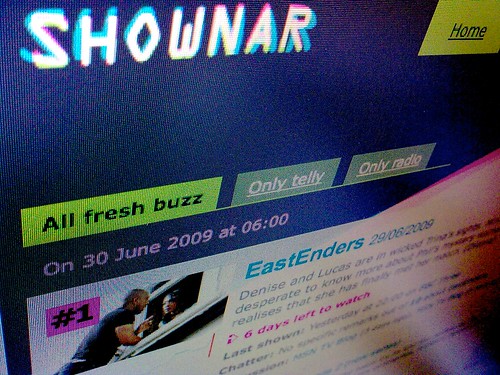It’s been around the internet a bit already, but I can now show you what I’ve been working on for much of the time since I joined Schulze & Webb.
Enter Shownar:

What’s Shownar? Matt explained it over at Pulse Laser, the Schulze & Webb blog:
Shownar tracks millions of blogs and Twitter plus other microblogging services, and finds people talking about BBC telly and radio. Then it datamines to see where the conversations are and what shows are surprisingly popular.
And over at the BBC Internet Blog, Dan Taylor quotes the about page:
First, it will help you find shows that others have not only watched, but are talking about. Hopefully it’ll throw up a few hidden gems. People’s interest, attention and engagement with shows are more important to Shownar than viewing figures; the audience size of a documentary on BBC FOUR, for instance, will never approach that of EastEnders, but if that documentary sparks a lot of interest and comment – even discussion – we want to highlight it. And second, when you’ve found a show of interest, we want to assist your onward journey by generating links to related discussions elsewhere on the web. In the same way news stories are improved by linking out to the same story on other news sites, we believe shows are improved by connecting them to the wider discussion and their audience.
Of course, I didn’t work on this alone; as Matt points out, there was a good-sized team from both the BBC and Schulze & Webb, and it was great to work with so many talented and sharp people, all of whom have left their mark on the project.
People have been pretty enthusiastic so far, which is always nice to see. It’s also great been watching stories emerge – stories of what we found to watch or listen to in the office, ways our viewing and listening habits have changed, and there’s not much better praise than constantly wanting to use a thing you’ve made.
So there we go, Shownar. Another thing in the world.